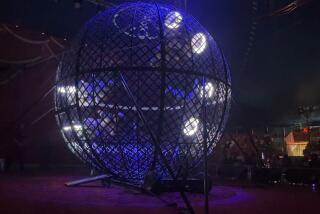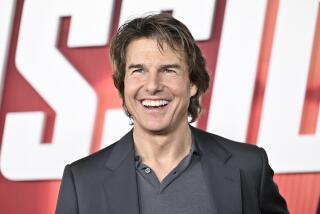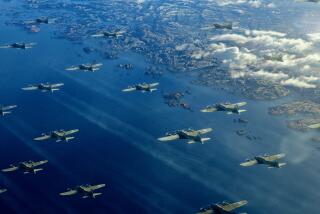Movie Sneaks: The ‘Impossible’ risks taken by high-flying Tom Cruise
On a chilly British day last fall, Tom Cruise clung to the outside of an Airbus A400 military aircraft as it waited on the tarmac. The director and crew members from his new movie, “Mission: Impossible — Rogue Nation,” were huddled inside the plane, preparing for a hugely risky stunt.
“I walked out of the aircraft just before we were going to take off, and Tom was hanging on the back and it was deafening and cold and there was a noxious wave of exhaust,” said the director, Christopher McQuarrie. “And I thought, ‘This must be what hell is like.’”
The nightmarish conditions were just beginning for Cruise — after all, the plane would soon speed down the runway and take off as the lightly harnessed actor held on for dear life, then land while he remained plastered to its exterior.
The improbable scene, which closes the trailer for the July 31 release, ups the ante for an actor who has made a career out of putting stuntmen out of work. In 2011’s “Mission: Impossible — Ghost Protocol,” Cruise flung himself off the tallest building in the world, Dubai’s Burj Khalifa, for the sake of a stunt. In the franchise’s latest installment, Cruise ascends to even greater heights — and this time the structure is flying.
Cruise decided to undertake the effort after McQuarrie, in planning the latest adventures of the franchise’s Ethan Hunt & Co., half-jokingly suggested to Cruise that a plane in the backdrop of a scripted scene become the centerpiece of a stunt sequence. Cruise sensed a challenge, and soon McQuarrie was both building a narrative and plotting out its logistics.
Long before a camera was rigged to the side of the plane, the crew, led by stunt coordinator and frequent Cruise collaborator Wade Eastwood, ran a rigorous battery of tests. On the ground, they simulated massive wind to see how it would affect Cruise. (His eyelids practically became pasted to the back of his eye sockets, for one thing.)
In the air, the crew conducted a test run in which they affixed a life-size dummy to the side of the plane and replicated the plane’s speed and altitude to see if the dummy would fall off. (It didn’t.)
Since Cruise was supposed to look scared in the scene, it would be impossible for McQuarrie to know if something was wrong or if Cruise was just doing a very good job acting. So the actor and director worked out a safe signal. If Cruise didn’t make it, McQuarrie shouldn’t stop the scene.
The biggest danger was a bird flying at Cruise — or into the engine. So an escape plan was conceived that would get Cruise back into the plane if anything went wrong with the aircraft as it maneuvered through airspace, and then it did again multiple times as the plane took off and landed for various takes.
Perhaps the trickiest form of navigation, though, was of a different variety. Initially, Airbus was reluctant to loan the A400 to the production; it would hardly be good publicity for its sleek new aircraft if one of the world’s biggest movie stars tumbled off it at 5,000 feet. Executives were especially reluctant because the takeoff would take place at a sharp angle much more common to an air show than a red-eye from LAX.
So Eastwood and his team constructed a plan to limit risk — it involved an advanced system of bird-spotters on board, among other precautions — then traveled to Airbus’ offices in Seville, Spain, and Toulouse, France, to press their case. Executives relented, eventually even allowing the production to use one of their most respected test pilots.
“I’m not going to lie — it was a stressful experience,” Eastwood said, giving a small laugh. “If anything happened I’d never work again — and that would be the least of our problems.” He added that Cruise and he have an in-joke at the end of every movie, in which the coordinator, having gone to the mattresses with the actor, tells Cruise “Never call me again” (until the next movie).
Eastwood and McQuarrie say that, in an age when so many action movies are CG creations, the goal with “M: I” is to build a movie that audiences can connect with in real time. Cruise, for instance, refused to wear goggles, believing that viewers would relate to the scene more without them.
Still, that spirit of adventure has to be tempered with careful planning. “Tom is very bold, but he’s acutely aware what any single injury would do to the production,” McQuarrie said. “Besides, no one wants to be killed by a sea gull.”
More to Read
Only good movies
Get the Indie Focus newsletter, Mark Olsen's weekly guide to the world of cinema.
You may occasionally receive promotional content from the Los Angeles Times.











